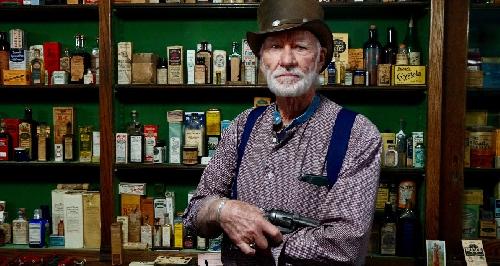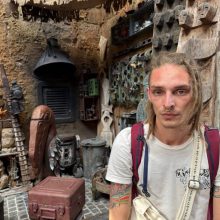So Much Depends on the Museum of the Mountain West in Montrose, Colorado (optional title)
We live in a disenchanted era, impoverished by a scientific materialism that has cast its sterilizing shadow on the aliveness of the world and its objects.
Each object has its moment of creation and stages of development and timespan of beingness. Each and every object has a history as surely as any person has a history.
Emerging from my Sprinter Van just now into the predawn darkness of the parking lot of the Walmart Supercenter in Durango, Colorado on September 28 of 2020, I stepped onto a small concrete peninsula of smooth river stones and felt my weight causing some of them to slide against each other and into new positions — a new and slightly abrasive event in individual stone histories that span billions of years.
Sitting precisely at the base of a small maple tree living in this little peninsula, I picked up a reddish river stone the size and shape of a large Idaho potato. It had exactly two green circles of lichen growth, a recent development in a story that began before there were people to observe it.
Millions or billions of days and nights at the bottom of a river have smoothed its edges and made it a Taoist, shaped by a thousand millennia of flowing river water, enduring and persevering with mineral stoicism the passing of eons.
A geologist could read the basic history of this stone better than me, read it like a book, but it would still only be the scientific version of storytelling, with chapter headings perhaps but with all the detailed pages missing.
Was this stone used to grind maize? Did a paleolithic man use it as a murder weapon to crack an enemy’s skull? In its late middle age was it trampled by the footpad of a brontosaurus submerging it into marshy mud where it lost contact with sunlight for a few million years?
You can call someone like me who perceives the aliveness of objects by fancy words like “animist” or ” panpsychist,” but there were people who felt the aliveness of the world and its objects before there were words and modern mental constructs that caused many unfortunates to become blind to that aliveness.
I bought a bumper sticker in Taos, New Mexico a few weeks ago that says, “Quantum Mechanics — The dreams stuff is made of.” Some physicists now say that the paradoxes of quantum mechanics are easily reconciled if you perceive that the phenomenal world is made of consciousness not solid objects.
There are no solid objects. “Matter,” said Einstein back in the day, “is just a special case of energy.” We and all objects are patterned energy. If all the empty space in all the atoms of our evermore obese population of seven billion were removed, we would all fit into one skinny sugar cube. And what would be in that sugar cube? Quarks, electrons — miniscule indeterminacies waiting for an observer to collapse their wave functions. In other words, the dreams that stuff is made of.
Things and people are not solid or frozen — they are patterned energy unfolding in a metamorphic process in the magnificent illusion of linear time. They are alive. They are made of consciousness not tiny billiard balls.
Objects made by human beings are all magical objects. Remember the classic definition of magick, “The science and art of creating change in conformity to will.” All manmade objects are, therefore, magical artifacts. And all of them have histories that involve relationships with humans.
Think of how much human will, intention, science, art, feeling and experience is contained in a Stradivarius. What a multigenerational history such an instrument could tell if we could get it to sing its song of existence in words as well as melodies!
If you want to feel the dreams that stuff are made of, there is no better place to go than the living time machine known as the Museum of the Mountain West in Montrose, Colorado, where exquisitely curated living artifacts of our near, and yet mostly vanished, American experience have been assembled into stores and saloons and doctor and dentist offices and such.
Imagine a turn-of-the-century mining town saloon where people have left half-full tumblers of bourbon sitting on a polished mahogany (please tell me what the actual saloon bar wood is so I can insert here) bar a moment before its inhabitants vanished into the night of time. Imagine if the space they had just inhabited were sealed up for a century and a score of years but dusted and tended to. Only—you don’t have to imagine it — you can walk into that saloon and so many other spaces for a ten-dollar bill. You can stand inside the many rooms of this living memory town feeling all the stories radiating from every part of it.
It’s all the inspiration of one 80-year-old man, Richard Fike, an archeologist focused on our recent vanished past, a man who began collecting artifacts of that past at the age of four, a man who has dug through the murky depths of outhouses to find revolvers that slipped from belt holsters or that were intentionally thrown into these unlikely time capsules because they were murder weapons still smelling of burnt gunpowder in the tragic-magic moment after the darkest page of their history.
Richard and scores of volunteers have lovingly retrieved these things and reassembled them into time capsule rooms you can experience in wooden structures in Montrose, Colorado.
It’s a massively priceless work of love and great labor and yet it currently has a leaky roof and needs patrons who have awakened to the aliveness and value of objects, objects that radiate the stories of our grandparents and great grandparents.
As William Carlos Williams put it in 1938 in his poem, The Red Wheelbarrow,
so much depends
upon
a red wheel
barrow
glazed with rain
water
beside the white
chickens
To which I would add,
So much depends on the Museum of the Mountain West, at risk from rainwater, in Montrose, Colorado.
So Much Depends on the Museum of the Mountain West in Montrose, Colorado (optional title)
We live in a disenchanted era, impoverished by a scientific materialism that has cast its sterilizing shadow on the aliveness of the world and its objects.
Each object has its moment of creation and stages of development and timespan of beingness. Each and every object has a history as surely as any person has a history.
Emerging from my Sprinter Van just now into the predawn darkness of the parking lot of the Walmart Supercenter in Durango, Colorado on September 28 of 2020, I stepped onto a small concrete peninsula of smooth river stones and felt my weight causing some of them to slide against each other and into new positions — a new and slightly abrasive event in individual stone histories that span billions of years.
Sitting precisely at the base of a small maple tree living in this little peninsula, I picked up a reddish river stone the size and shape of a large Idaho potato. It had exactly two green circles of lichen growth, a recent development in a story that began before there were people to observe it.
Millions or billions of days and nights at the bottom of a river have smoothed its edges and made it a Taoist, shaped by a thousand millennia of flowing river water, enduring and persevering with mineral stoicism the passing of eons.
A geologist could read the basic history of this stone better than me, read it like a book, but it would still only be the scientific version of storytelling, with chapter headings perhaps but with all the detailed pages missing.
Was this stone used to grind maize? Did a paleolithic man use it as a murder weapon to crack an enemy’s skull? In its late middle age was it trampled by the footpad of a brontosaurus submerging it into marshy mud where it lost contact with sunlight for a few million years?
You can call someone like me who perceives the aliveness of objects by fancy words like “animist” or ” panpsychist,” but there were people who felt the aliveness of the world and its objects before there were words and modern mental constructs that caused many unfortunates to become blind to that aliveness.
I bought a bumper sticker in Taos, New Mexico a few weeks ago that says, “Quantum Mechanics — The dreams stuff is made of.” Some physicists now say that the paradoxes of quantum mechanics are easily reconciled if you perceive that the phenomenal world is made of consciousness not solid objects.
There are no solid objects. “Matter,” said Einstein back in the day, “is just a special case of energy.” We and all objects are patterned energy. If all the empty space in all the atoms of our evermore obese population of seven billion were removed, we would all fit into one skinny sugar cube. And what would be in that sugar cube? Quarks, electrons — miniscule indeterminacies waiting for an observer to collapse their wave functions. In other words, the dreams that stuff is made of.
Things and people are not solid or frozen — they are patterned energy unfolding in a metamorphic process in the magnificent illusion of linear time. They are alive. They are made of consciousness not tiny billiard balls.
Objects made by human beings are all magical objects. Remember the classic definition of magick, “The science and art of creating change in conformity to will.” All manmade objects are, therefore, magical artifacts. And all of them have histories that involve relationships with humans.
Think of how much human will, intention, science, art, feeling and experience is contained in a Stradivarius. What a multigenerational history such an instrument could tell if we could get it to sing its song of existence in words as well as melodies!
If you want to feel the dreams that stuff are made of, there is no better place to go than the living time machine known as the Museum of the Mountain West in Montrose, Colorado, where exquisitely curated living artifacts of our near, and yet mostly vanished, American experience have been assembled into stores and saloons and doctor and dentist offices and such.
Imagine a turn-of-the-century mining town saloon where people have left half-full tumblers of bourbon sitting on a polished mahogany (please tell me what the actual saloon bar wood is so I can insert here) bar a moment before its inhabitants vanished into the night of time. Imagine if the space they had just inhabited were sealed up for a century and a score of years but dusted and tended to. Only—you don’t have to imagine it — you can walk into that saloon and so many other spaces for a ten-dollar bill. You can stand inside the many rooms of this living memory town feeling all the stories radiating from every part of it.
It’s all the inspiration of one 80-year-old man, Richard Fike, an archeologist focused on our recent vanished past, a man who began collecting artifacts of that past at the age of four, a man who has dug through the murky depths of outhouses to find revolvers that slipped from belt holsters or that were intentionally thrown into these unlikely time capsules because they were murder weapons still smelling of burnt gunpowder in the tragic-magic moment after the darkest page of their history.
Richard and scores of volunteers have lovingly retrieved these things and reassembled them into time capsule rooms you can experience in wooden structures in Montrose, Colorado.
It’s a massively priceless work of love and great labor and yet it currently has a leaky roof and needs patrons who have awakened to the aliveness and value of objects, objects that radiate the stories of our grandparents and great grandparents.
As William Carlos Williams put it in 1938 in his poem, The Red Wheelbarrow,
so much depends
upon
a red wheel
barrow
glazed with rain
water
beside the white
chickens
To which I would add,
So much depends on the Museum of the Mountain West, at risk from rainwater, in Montrose, Colorado.
 ZapOracle.com home to the free 720-card Zap Oracle
ZapOracle.com home to the free 720-card Zap Oracle






